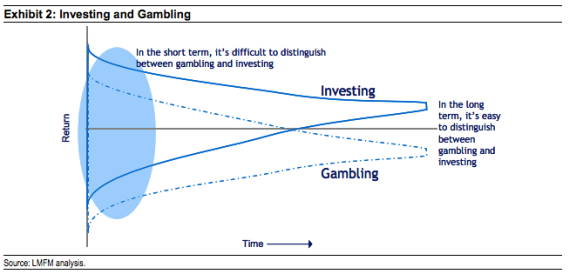Chart: What Is the Difference Between Investing and Gambling?
This is a question that comes up often from students and I finally found the chart that explains it better than I can (from Michael Mauboussin’s paper “Decision Making for Investors“):
Answer: It’s all about the time horizon:
As the chart above indicates, the distribution of their expected returns may look similar in the short term (left side of Y axis), however they diverge in the long-run. For example, it is extremely difficult in the short-term to know how stock prices for a company or index will behave (despite the confidence you see from the talking heads on CNBC) just as it was difficult to predict who was going to win the NCAA Men’s Basketball championship (much easier on the Women’s side as UConn has won the last three years). This explains the wide dispersion of potential returns for both investing and gambling (i.e, you may win a lot of money with a lucky stock pick or bet OR you could lose a lot of money).
We know that the House enjoys an advantage when it comes to gambling which leads to the negative expected return in the long-run (i.e., you will lose money!). Meanwhile, investing over the long-term has a positive expected return. So, the next time someone tells you that investing is just legalized gambling, tell them it all depends on their time horizon!
—————–
Check out NGPF’s Investing Activity “Asset Allocation Using Excel“
![]()
About the Author
Tim Ranzetta
Tim's saving habits started at seven when a neighbor with a broken hip gave him a dog walking job. Her recovery, which took almost a year, resulted in Tim getting to know the bank tellers quite well (and accumulating a savings account balance of over $300!). His recent entrepreneurial adventures have included driving a shredding truck, analyzing executive compensation packages for Fortune 500 companies and helping families make better college financing decisions. After volunteering in 2010 to create and teach a personal finance program at Eastside College Prep in East Palo Alto, Tim saw firsthand the impact of an engaging and activity-based curriculum, which inspired him to start a new non-profit, Next Gen Personal Finance.
SEARCH FOR CONTENT
Subscribe to the blog
Join the more than 11,000 teachers who get the NGPF daily blog delivered to their inbox:
MOST POPULAR POSTS
3










